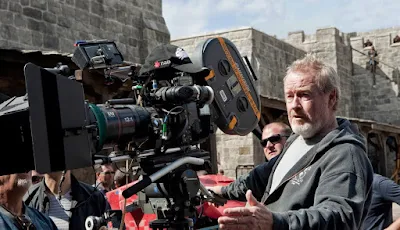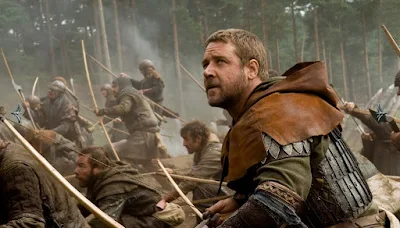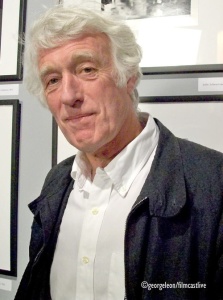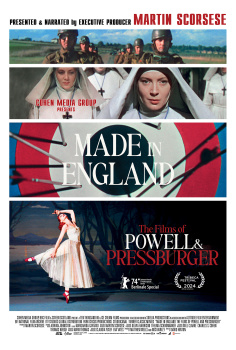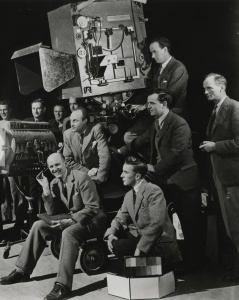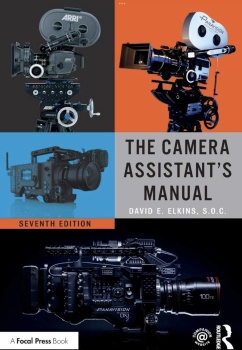The outlaw of 15th century ballad has undergone a modern movie makeover courtesy of Ridley Scott and Universal. The cinema chatter factory of the blogosphere (yours truly included) is all lit up over Scott’s Robin Hood (starring Russell Crowe as Hood and Cate Blanchett as Lady Marion) playing opening night at the 63rd annual Cannes Film Festival on Wednesday, May 12, and opening in the U.S. two days later. The script was originally entitled Nottingham, with the titular town's sheriff as protagonist. Crowe wasn't thrilled with that concept. After a rewrite from Brian Helgeland (L.A. Confidential and Mystic River) Robin Hood was born. I'm fairly certain you can guess who the hero of that version is.
So what can we expect from this neo-Hood? Some things have changed over the centuries. His Men sound less Merry and more martial. Another notable modification for these third-wave feminist times involves the movie’s Maid. Under Scott's lens, Marion has gone from virginal victim to warrior widow. Perhaps as an indication of changing gender roles, she has traded her distressed damsel act in for a sword on the battleground and a dagger in the bedroom. Although, in a
well-researched Observer article, Vanessa Thorpe notes that these rebellious tendencies were in Marion’s mythology all along, but that in some cases they just got lost along the way.


Initial reports suggest that the film is well acted and shot (which isn't surprising in light of Scott's track record for visual effects Oscars) by cinematographer John Mathieson
ASC, BSC but that it’s less lively than one might have hoped. This seems odd given that Scott's work usually bursts at the seams with every kind of action, ranging from beautiful android (Blade Runner); pregnant extraterrestial (Alien); punchy Roman slave (Gladiator); and spunky housewife (Thelma & Louise) fare; to the heroin-smuggling Harlem mobster (American Gangster); professorial cannibal (Hannibal) and general Russell Crowe kind of action (Gladiator, A Good Year, American Gangster, Body of Lies, and now Robin Hood).
The camera package provided by Panavision included ARRICAM
Studio, ARRICAM Lite, and ARRIFLEX 235 bodies with a range
of Primo prime and compact zoom lenses. Some daylight exterior
scenes were recorded on KODAK VISION2 250D 5205 and
50D 5201 emulsions, but D.P Mathieson used more 5219 film than
he had anticipated, because there were many days when the woods
were very dark in daylight. “We tried to plan, but there were
surprises all the time, including schedule changes and bad
weather,” he says.“Most of the time rain doesn’t photograph,
especially in the soft light coming through trees that are
covered with leaves".
Perhaps all Robin Hood’s animation took place
behind the scenes between Crowe and Scott, who have become the bickering old married couple of movies. As an amusing side note: Crowe may be the common denominator in Scott’s films of late, but it is Sean Connery who fills this position for Robin Hood productions. Although Errol Flynn’s portrayal is probably the most celebrated, and Disney's boasted the most anthropomorphic animal toons, Connery has the distinction of being most frequently found in Robin films (Robin and Marian and Robin Hood: Prince of Thieves); and when he’s not in them, he sends his son (who portrayed Hood in the British TV series Robin of Sherwood).
Watch Robin Hood Featurette On-Demand.
Check our Playlist in our main video window above
If these early reviews are to be believed, there is no joy in Hoodville. Although Scott’s favorite interpretation of the famous outlaw is Mel Brooks' Robin Hood: Men in Tights (1993), he didn’t take a leaf out of Brooks' humor book here. The film's supposed staid quality led
Roger Friedman to wonder, "Does the public want a dark, brooding Robin Hood who takes Sherwood Forest seriously?" I'm not sure the world is ready for a serious Sherwood, but If I were to tell Robin Hood’s fortune, I would say that it will be extremely successful for one very time-sensitive reason.
This tale of an outsider leader fighting the corrupt old despot, and the fat cats who are getting richer while the poor get poorer, will resonate with today’s America. All that’s missing is an accusation that Robin is really
a radical Muslim who wants to sink the national ship. Yet Scott is already pondering a sequel, so I suppose there's still time.
Caroline Hagood is our guest writer and she is a poet and writer living in New York City. She has written on books, film and culture for Salon, the Huffington Post, Film International, Film-Philosophy, Film Catcher, The Journal of Popular Culture, and in her own blog, Culture Sandwich .




